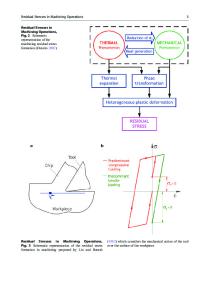Residual stresses in functionally graded plates
- PDF / 290,259 Bytes
- 9 Pages / 612 x 792 pts (letter) Page_size
- 50 Downloads / 393 Views
Eric D. Steffler Idaho National Engineering and Environmental Laboratory, Idaho Falls, Idaho 83415
Theo Fett Forschungszentrum Karlsruhe, IMF II, 76021 Karlsruhe, Germany (Received 23 April 2002; accepted 21 August 2002)
Macroscopic residual stresses in Al2O3/Al plates of graded composition were determined experimentally and by the finite element method (FEM). Experimental stress data were determined by sawing a notch in the plates and measuring displacements by Moire´ interferometry. Residual stresses were calculated from the displacements using the weight function method. Experimentally determined stresses agreed with FEM data only if measured thermomechanical properties for the different compositions were used for finite element calculations.
I. INTRODUCTION
Functionally graded materials (FGMs) are materials possessing a spatial variation of properties that have increasingly attracted scientific and technological interest in the past decade.1,2 A prominent feature of these materials is that they can prevent stress singularities at material interfaces3 and redistribute residual or working stresses in the bulk of the material. To find favorable profiles for the thermomechanical property gradient, stresses in FGMs have to be assessed. For plates or beams and elastic material behavior, stresses can be calculated analytically.4,5 For other specimens with simple geometry, approximate solutions for residual stress calculations exist.6 The most widespread methods for stress analysis are elastic7 and elastic plastic8,9 finite element method (FEM) calculations. Typically, rules of mixture are used to estimate the thermomechanical material properties necessary for the stress calculation. Experimentally, macrostresses in FGMs were determined by x-ray diffraction (for near surface stresses) and neutron diffraction (for stresses in the interior of the graded material). The spatial resolution of these methods depends on the aperture system employed and can be better than 1 mm. Rabin and co-workers determined the stresses in a cylindrical Al2O3/Ni FGM specimen using neutron diffraction and found only qualitative agreement
of the axial stresses with an elasto-plastic FEM analysis.10 In a more recent paper, Bokuchava et al. determined macrostresses in a W/Cu FGM and found a semiquantitative agreement with FEM calculations.11 For graded materials with a metal matrix, very good spatial resolution can be achieved by a technique where thin metal layers are electrochemically removed from a thin plate and the bending of the specimen is observed.12 Here, the spatial resolution of the residual stress measurement is better than 50 m. A similar method has been used by Kesler et al. to determine the residual stresses in FGM specimens.13 In principle, methods capable of measuring stresses in layered structures can be applied to graded structures. An example is an indentation technique proposed by She et al.14 to estimate the residual stresses near the surface of a layered alumina– zirconia/alumina–mullite composite. In this method the re
Data Loading...











